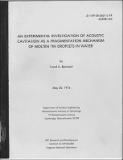An experimental investigation of acoustic cavitation as a fragmentation mechanism of molten tin droplets in water
Author(s)
Bjørnard, Trond Arnold
Download856983998.pdf (4.371Mb)
Other Contributors
Massachusetts Institute of Technology. Department of Nuclear Engineering
U.S. Atomic Energy Commission
Argonne National Laboratory
Metadata
Show full item recordAbstract
A series of experiments were performed where single molten tin droplets of known size, shape and temperature were dropped from a low height into a pool of distilled water. The pressure waves emanating from the hot droplets were recorded by a transducer in the coolant for varying initial droplet and pool temperatures. The results obtained show well defined patterns of pressure frequency and magnitude behavior. Application of the results to the acoustic cavitation theory of fragmentation shows that the pressure excursions within the molten tin are considerably less severe than was predicted. The likelihood that acoustic cavitation caused the observed fragmentation is therefore considerably diminished. Further, the results strongly suggest that spontaneous nucleation of the coolant did not cause the observed fragmentation, while it appears that another mechanism linked to the observed dwell time behavior was responsible. Further theoretical and experimental work is required to establish the nature of this mechanism.
Description
"May 30, 1974." Also issued as an M.S. thesis, MIT, Dept. of Nuclear Engineering, 1976, (c1975) Includes bibliographical references (pages 110-112)
Date issued
1974Publisher
Cambridge, Mass. : Dept. of Nuclear Engineering, Massachusetts Institute of Technology, [1974]
Series/Report no.
MITNE ; no. 163AEC research and development report